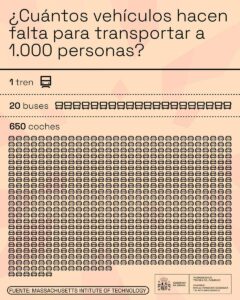
La mobilitat en els desplaçaments de casa a la feina i de la feina a casa en vehicle particular genera grans embussos de trànsit i és un dels grans factors que contribueixen a la contaminació ambiental i el canvi climàtic.
Pensem que la reducció de gran part d’aquests inputs contaminants és necessària, imprescindible pel futur de la vida al planeta. I en el nostre sector és possible.
Amb l’objectiu de reduir la contaminació, l’empremta de carboni, les emissions contaminants en els trajectes laborals de casa a la feina, aconseguir un planeta solidari, sostenible i complir amb els Objectius de Desenvolupament Sostenible, proposem:
La racionalització de la distribució dels i les treballadores de la Generalitat de Catalunya a l’educació pública infantil, primària, secundària obligatòria i batxillerat prenent com a criteri estructural la proximitat entre la localitat de residència i la de treball.
És ben comú que una mestra d’educació primària resident a Barcelona es desplaci a Canovelles cada dia a treballar, i viceversa. I així per tots els estudis amunt esmentats. La Plantilla docent de la Generalitat ascendeix a més de 80.000 persones. L’impacte de la seva mobilitat diària no és pas residual.
L’acostament de distàncies entre les localitats de residència i treball també millora la conciliació de la vida laboral i familiar, els espais de cures, fa guanyar temps, qualitat de vida, benestar i salut entre els i les treballadores.
Plantegem aquests col·lectius de treballadores principalment perquè són els més abundants i generalitzats (inclòs les especialitats de l’educació secundària) i més fàcilment intercanviables de manera recíproca amb criteris de mobilitat.
Tanmateix considerem que aquest hauria de ser un criteri estructural de totes les Administracions Públiques en l’adjudicació de places i concurs de trasllats.
Que aquesta mateixa hauria de ser la línia d’actuació del Departament d’Educació de la Generalitat de Catalunya en estudis més especialitzats, en tant sigui possible.
PROPOSEM:
Que siguin convocats concursos de trasllats oferint de manera pedagògica, troncal i prioritària la possibilitat pràctica d’acostament del lloc de treball al de residència.
L’assignació de places resultats de concurs públic utilitzant com a prioritari el criteri de proximitat entre la localitat de residència i a de treball.






Sorry, the comment form is closed at this time.